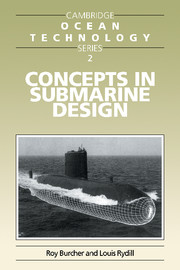Book contents
- Frontmatter
- Contents
- Introduction
- Acknowledgements
- 1 Design in general
- 2 Milestones in submarine history
- 3 Submarine hydrostatics
- 4 The weight/space relationship
- 5 Submarine structures
- 6 Powering of submarines
- 7 Geometric form and arrangements
- 8 Dynamics and control
- 9 Submarine systems
- 10 Considerations of building and costs in design
- 11 Generating a concept design
- Appendix 1 Hydrostatic conditions of flotation
- Appendix 2 Operational practice for keeping in trim
- Appendix 3 Assessing weight and size of variable ballast
- Appendix 4 Submarine pressure hull strength (Prediction of interframe collapse pressures)
- Appendix 5 Estimates of resistance and propulsion
- References and suggested reading
- Index
4 - The weight/space relationship
Published online by Cambridge University Press: 05 July 2014
- Frontmatter
- Contents
- Introduction
- Acknowledgements
- 1 Design in general
- 2 Milestones in submarine history
- 3 Submarine hydrostatics
- 4 The weight/space relationship
- 5 Submarine structures
- 6 Powering of submarines
- 7 Geometric form and arrangements
- 8 Dynamics and control
- 9 Submarine systems
- 10 Considerations of building and costs in design
- 11 Generating a concept design
- Appendix 1 Hydrostatic conditions of flotation
- Appendix 2 Operational practice for keeping in trim
- Appendix 3 Assessing weight and size of variable ballast
- Appendix 4 Submarine pressure hull strength (Prediction of interframe collapse pressures)
- Appendix 5 Estimates of resistance and propulsion
- References and suggested reading
- Index
Summary
PURPOSE
4.1 We start this relatively brief chapter with an explanation of its purpose, because it is different in character from the other technical considerations involved in submarine design. In some ways it is not especially technical at all, but rather akin in nature to the debates on spatial design which architects indulge in. The issues which arise in consideration of the weight/space relationship for submarines might appear at first sight to be simple – they certainly are very basic – but that is deceptive because they become progressively more complicated as the relationship is explored in greater detail. Although the subject of weight and space and how they are related in submarine design is associated with hydrostatics, it goes beyond what can properly be treated under that heading because of the somewhat intangible nature of the relationship and its consequences in some regards as compared with the more matter of fact nature of hydrostatics.
The chapter is ultimately about ‘what determines the size of a submarine’? In a particular submarine design, does it have to be of a certain size to provide enough buoyancy to support its weight or does it have to be of that size to provide enough space for its contents, so that it then has more than enough buoyancy to support its weight? If the former, there would be some space to spare, so how could the extra space be utilised?
Information
- Type
- Chapter
- Information
- Concepts in Submarine Design , pp. 52 - 70Publisher: Cambridge University PressPrint publication year: 1994
